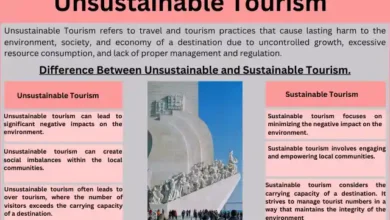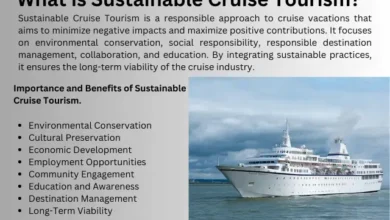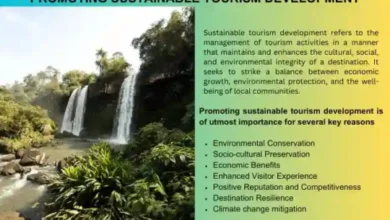
Strategies for sustainable tourism
Strategies for sustainable tourism development. Tourism has always been an important contributor to the economic growth of many countries, especially developing ones. However, tourism can also cause serious problems that result in environmental degradation and cultural loss, if not properly managed. Sustainable tourism development (STD) seeks to find ways to reduce these harmful effects while still allowing tourism to contribute to the local economy and maintain its cultural identity.
Strategies for Sustainable Tourism
Although sustainable tourism is often considered an evolving concept, there are a few common practices that most successful destinations use to stay at the forefront of sustainability. From green building techniques to local food programs, here are six must-have strategies for sustainable tourism development. One of the strategies for sustainable tourism development is ensuring all products and services used in the destination promote sustainability.
Another of the strategies for sustainable tourism development involves setting up waste management systems to be as efficient as possible.
One way to reduce air pollution from cars during peak hours and create a greener destination is by implementing congestion charges, which may require users to purchase parking permits depending on their needs. Another important consideration for sustainable tourism development is reducing car dependence through public transportation, ride-sharing, and bike rentals.
Another important strategies for sustainable development when developing sustainable tourism destinations is limiting urban sprawl through density planning, smart growth strategies, or revitalizing old areas instead of constructing new ones. When it comes to affordable housing in tourist hotspots like Hawaii or California, communities should look into innovative construction methods such as pre-fabricated homes or tiny houses that are more cost-effective than traditional home building.
Another innovation for sustainable tourism development is finding ways to re-purpose old buildings and infrastructure that can no longer support high traffic volume. For example, San Francisco found success with its adaptive reuse program where old buildings are converted into office spaces, hotels, or other modernized uses. In addition to these major factors, some smaller aspects of sustainable tourism development include investing in Eco-friendly guest amenities such as low-flow faucets and LED lighting while also giving back to the community through educational opportunities and volunteering initiatives.
Strategies for Sustainable Tourism; Quality Assurance:
Sustainable tourism development is often touted as being very much in line with achieving many of humanity’s 21st-century goals. Green, unspoiled beaches, clear blue water, and empty forests seem to fit with alleviating poverty, curbing climate change, and avoiding resource depletion.
However, providing services like these without impacting existing local resources is not just a good idea it’s an essential part of both creating a truly successful tourism destination AND preserving it for future generations. Tourism experts estimate that it takes 20 years or more to build up infrastructure before tourists start arriving.
Maintaining this quality is something that cannot be taken lightly, so these critical issues must be considered at every step along the way: from initial site selection, through transportation planning and construction methods, all the way up to managing visitor behavior onsite and after they leave. Aspects of sustainable tourism include natural habitats management, heritage preservation, and cultural values protection.
While all countries have their own unique natural and cultural assets, there are many principles that can apply universally. For example, appropriate technology can help minimize waste while maximizing efficiency; low-impact transportation minimizes congestion; integrated rural development can provide needed jobs and improve living standards; green building practices use materials efficiently and lessen environmental impact; traditional crafts help preserve skills; reduced packaging helps keep trash out of landfills.
Strategies for Sustainable Tourism; Research Funding:
The travel and tourism industry is one of the largest industries in both size and economic impact. It also has a major impact on cities, regions, and communities. As a result, people have recognized that there is an incentive to manage tourism responsibly in order to keep it green or sustainable (Sustainable Travel International).
Within that context, there are two broad kinds of sustainability: social sustainability and environmental sustainability. What are some ways these elements can be developed in combination with each other? To develop social sustainability, entrepreneurs should consider creating shared value by looking for ways to do more than just increase profit margins.
Instead, they should look for opportunities to help solve problems related to poverty while generating revenue at the same time. They should also consider empowering their employees by providing them with relevant training opportunities and regular pay increases. To develop environmental sustainability, entrepreneurs need to find new uses for materials that would otherwise end up in landfills. For example, garments that don’t sell after six months can be recycled into insulation fabric.
Entrepreneurs could also adopt environmentally friendly measures such as renewable energy use, water conservation techniques, carbon footprint reduction methods, better waste management practices, Eco-friendly building standards, and transportation infrastructure.
Strategies for Sustainable Tourism; Building Consensus:
Sustainable tourism is, at its core, a way to reduce negative impacts on natural resources. The most important way to do that is through stakeholder participation which means including all relevant stakeholders in planning and execution.
This can take many forms; for example, when locals participate in small-scale ecotourism, they’re rewarded for their expertise with jobs. Local businesses benefit from eco-tourists increased spending power, which leads to more job opportunities for locals. Additionally, direct contact between visitors and local people may lead to a better understanding of cultures.
This brings us back to the importance of an inclusive approach: not only should everyone be included in tourism’s growth but everyone should also be included in tourism’s planning process so as not to disadvantage any group or region along the way.
The challenge then becomes how you include diverse groups while respecting their needs. For instance, indigenous communities have unique cultural practices which outsiders might find disturbing. Therefore, respect for these communities often takes precedence over other economic considerations like maximizing profits.
In this case, it might be more worthwhile to set up an ecotourism project than a commercial venture because there will be fewer financial benefits if it has adverse effects on the community. Ultimately though, it is up to each community and country to figure out what form of tourism best suits them given their specific conditions.
Strategies for Sustainable Tourism; Innovative Approach:
It’s not just about advertising; it’s about finding creative ways to promote your product or service. For example, giving a free sample with every purchase could encourage new consumers to try your products. Or, handing out flyers at local events and fairs can help get you to face time with people who may not yet know about your products or services.
Creative marketing gets people talking about what you offer and that can go a long way toward building a successful business for years to come. The other major component of sustainability is the environment itself. Sustainable tourism takes into account environmental conservation issues such as endangered species protection, biodiversity conservation, climate change mitigation, energy consumption, and renewable energy use (sometimes known as green initiatives).
One way to ensure that our planet’s resources will be around for future generations is by recycling– think about how many bottles we use today when we fill up our cars with gas! Many travel providers have also recognized this need and have created green packages. These tours include destinations that work to protect the environment while still providing amazing experiences. A few examples of these types of tours are beach camping, Eco-friendly cooking classes, bird-watching tours, and cycling through New Zealand’s wine region.
Strategies for Sustainable Development; Digitalization:
More and more people around the world are accessing information online, and many are using smartphones to do so. Sustainable tourism professionals should be sure their website is mobile-friendly; if they don’t have a site, they should consider starting one. They should also use social media and other tech tools to reach travelers with special needs, including those who may not speak English or read print well.
It’s important for these efforts to be adapted for locals as well since studies show that more than half of developing country populations are connected. Furthermore, it has been shown that when communities are involved in shaping the development of their area (for example by creating community projects), there will be greater levels of buy-in and sustainability.
Additionally, recognizing and rewarding local residents’ contributions can encourage them to stay invested in an area rather than migrate elsewhere for better opportunities. To achieve this, include locals in decision-making processes, give them employment opportunities, offer housing options at affordable prices, and provide educational resources.
1) Include locals in decision-making processes: Developing successful models for equitable partnerships between tourists and local communities is key to building sustainable destinations. Host countries often want control over what happens on their land but partnering with locals allows them to feel like partners instead of observers.
For example, members of local communities can help decide where infrastructure should go, how accommodations will look, which services visitors might need, and how newcomers will interact with the locals. With input from both parties throughout the planning stages, tourist areas are able to grow naturally into something that is mutually beneficial for all parties involved.
2) Give them employment opportunities: People tend to invest more in places where they work and live they take care of what’s theirs so make sure your project includes job training programs for locals.
3) Offer housing options at affordable prices: Many poor rural families move to urban centers to find jobs and opportunities, leaving behind family farms and forests.
Urbanization puts stress on already overcrowded cities and leads to increased pollution, traffic congestion, food insecurity, deforestation, water scarcity, and increased greenhouse gas emissions. The best way to alleviate this problem is through the provision of adequate housing solutions that are near public transportation routes and offer access to amenities such as schools, parks, hospitals, etc.
Strategies for Sustainable Tourism at all levels:
To make a significant impact on sustainability and reduce your environmental footprint, you need to incorporate sustainable practices at all levels of operations including employee training, energy efficiency, and waste management. The best way to ensure that these practices become ingrained in an organization is to involve employees at every level of planning, decision-making, and implementation.
You’ll be more likely to have enthusiastic support from everyone when they see that their efforts are helping contribute towards a greener business culture. One example of this would be green building standards. These standards can help save up to 50% in energy costs for buildings (source). Encourage Staff Incentives: To motivate staff members, encourage them with incentives like reducing their carbon emissions through carpooling or bike riding or providing recycling stations for recyclable materials that create less trash.
Employees who feel invested in your company will feel motivated to go above and beyond what’s expected. It also helps if you show appreciation for the work that people do, which provides an incentive for people to work harder and longer. Implementing green initiatives doesn’t always mean it has to cost money; there are plenty of ways to incorporate sustainability into your workplace.
For instance, creating designated quiet spaces where workers can take breaks without disturbing others around them or starting a program that involves recycling unused items rather than throwing them away could not only help improve morale but decrease consumption and wastefulness as well.
Conclusion:
Tourism is a popular industry in all parts of the world. It is important for tourists to be aware that even though travel has become more accessible, it does have its consequences. Tourism not only impacts transportation, lodging, and dining but also health and safety. With proper planning, resorts can thrive and prosper without compromising their environment or their guests.
Strategies for Sustainable Tourism must be integrated into modern business models at every level. For example, hotels should make provisions for recycling amenities like towels and sheets so there is less waste. The hotel should try to minimize excessive water usage by implementing low-flow toilets, rainwater harvesting systems, recycling wastewater for irrigation, and using recycled construction materials where possible.
In addition, restaurants should encourage people to bring their own dishes instead of relying on disposables which create much waste that eventually finds its way into landfills. Tourists should remember that they play an important role in sustainability efforts as well. People who come to visit a new place need to tread lightly when they explore, show respect for the culture, and ask permission before taking pictures. If everyone takes these measures then future generations will continue to enjoy tourism’s benefits while we take care of our planet.





excellent points altogether, you just gained a brand new reader. What would you recommend in regards to your post that you made a few days ago? Any positive?
Thanks for your compliment.